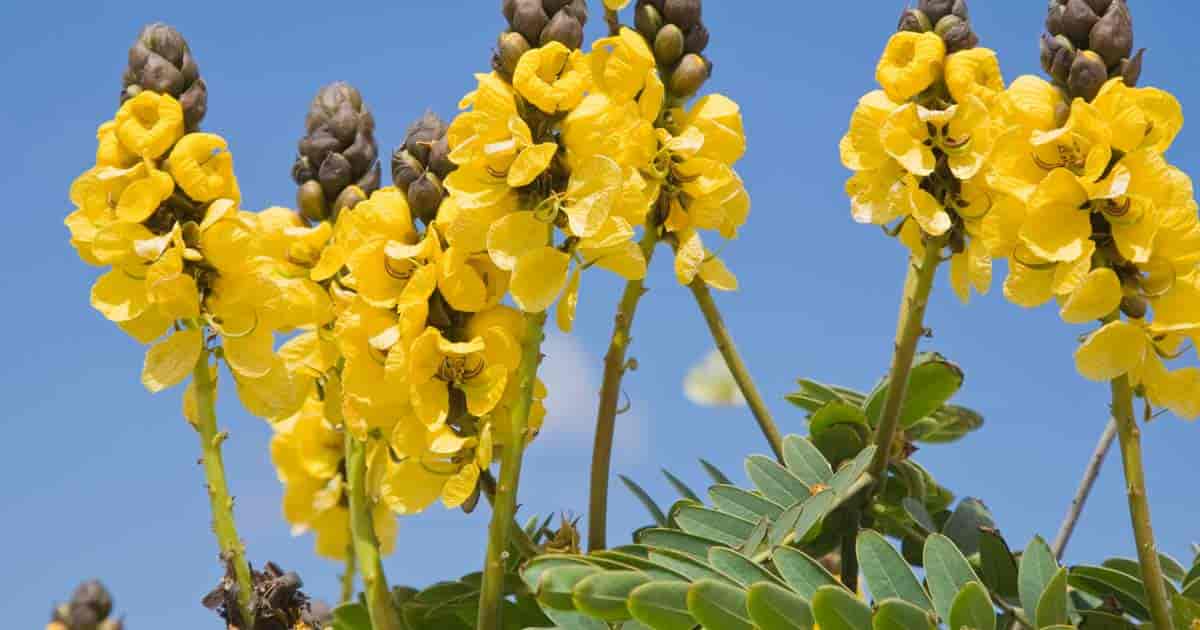Cassia didymobotrya [KASS-ee-uh, did-ee-mo-BOT-ree-uh] known as Senna Didymobotrya is a perennial flowering plant species from the family Fabaceae, commonly known as the legume, bean, or pea family.
The plant is native to Africa where it is seen growing in a variety of habitats throughout the continent but is mainly found in the tropical regions of eastern and central Africa.

Didymobotrya has been introduced to many other parts of the world and has even been naturalized in the wild in some parts of the United States, Mexico, Australia, and Indonesia.
While it is originally a tropical plant, it can grow in cooler climates as an annual plant.
Other than the botanical name it’s commonly known as:
- Popcorn Bush
- Popcorn Senna
- African Senna
- Peanut Butter Cassia
- Candelabra Tree
- Popcorn Cassia Plant
Popcorn Cassia Care
Size & Growth
Popcorn Bush is a semi-deciduous grower typically growing to the height of 6’ – 10’ feet but has been known to reach up to 25’ feet high.
When grown as an annual plant, the plant doesn’t usually grow past a couple of feet in height.
It features bright green colored, large, leathery, and pinnate compound leaves covered with tiny hair.
Just like the length of the leaves, the length and thickness of the hair will vary among the plants that grow in their natural habitat and the ones are grown in containers.
One of the distinguishing characteristics of cassia is the strong, but peculiar scent the foliage gives off when rubbed or bruised.
It’s described differently by different people.
Some describe it as the smell of buttered popcorn or peanut butter (hence, the common names).
Others think it smells like a wet dog.
Flowering and Fragrance
The blooming period of African senna starts in spring and continues till fall, but it produces most flowers in late summer.
The axillary racemes are erect and reach up to 1’ foot long.
The unopened buds are enclosed by a brownish-green or black bract which opens allowing five petals to emerge.
One raceme has about 20 to 30 bright yellow flowers with a mild fragrance and they contrast against striking black buds on flower spikes.
The plant exhibits a unique pattern when the flower buds start opening – the buds start opening from the bottom of the inflorescence.
Flowering is followed by the production of fruits; about 5″ inches long, flat, brown-colored pods containing up to 16 bean-like seeds.
Light & Temperature
Peanut Butter cassia is a tropical plant preferring warm weather and grows best in full sun.
But, as mentioned above, it can grow in cool climates as an annual plant.
Although it may tolerate light frost, it cannot tolerate extreme winters, which is why it is recommended to keep it indoors or in a greenhouse when temperatures fall too low.
USDA hardiness zone 10.
Watering and Feeding
This legume species requires ample water and humidity to grow properly, so make sure to water the plant regularly.
Fertilizing the plant once a month helps to promote growth and flowering.
Once it’s established it’s drought tolerant.
Soil & Transplanting
Popcorn cassia thrives in rich, moist, and well-drained soil.
Grooming and Maintenance
The plant doesn’t require much maintenance but may need to be pruned to be kept compact.
After flowering, prune as needed.
However, it will delay the next blooming.
How To Propagate Popcorn Bush?
New plants are typically grown from seeds in their natural habitat and from rooted cuttings in non-tropical areas where it is grown as annual plant.
Propagating through cuttings, however, is difficult.
When propagating through seeds, soak them in water for about 24 hours (preferably in warm water) and then sow shallowly in rich, moist, and well-draining soil.
Soaking in water ensures the seeds germinate more readily.
February and March are the best months to sow the seeds, but make sure to keep the plant indoors or in a greenhouse until the end of the frost season and then plant outdoors in full sun.
If using cuttings, plant them in spring.
African Senna Pest or Diseases
Popcorn cassia plants do not face any significant pest problems or diseases.
Uses For Popcorn Senna
This flowering legume species is grown both as an ornamental house plant, due to its bright, showy flowers, and a cover crop.
It’s used as a legume green manure.
Pair it with pink cosmos and orange dahlias for a bright burst of flower color.